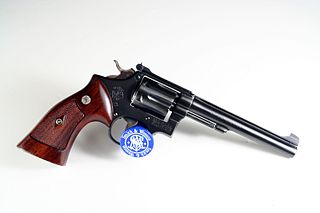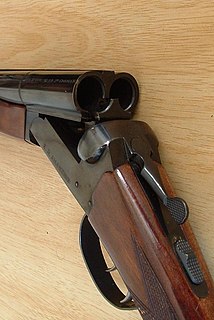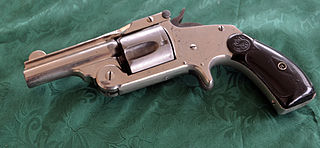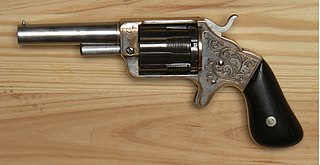
A hand ejector is a revolver design that is used on most double-action revolvers to this day.

A hand ejector is a revolver design that is used on most double-action revolvers to this day.
A hand ejector is characterized by a cylinder that swings out on a hinge (known as a crane) and requires the pushing of a concentric rod toward the cylinder to eject the spent cases from the cylinder. The term "hand ejector" (though not the design itself) was originated by Smith & Wesson to differentiate this class of revolver from the "top break" design, in which rotating the barrel together with the cylinder up and away from the gun's frame would "automatically" eject the cases. [1]

A revolver is a repeating handgun that has at least one barrel and uses a revolving cylinder containing multiple chambers for firing. Before firing a round, cocking the hammer partially rotates the cylinder, indexing one of the cylinder chambers into alignment with the barrel, allowing the bullet to be fired through the bore. The hammer cocking can be achieved by either the user manually pulling the hammer back, via internal linkage relaying a rearward movement of the trigger, or both. By sequentially rotating through each chamber, the revolver allows the user to fire multiple times until having to reload the gun, unlike older single-shot firearms that had to be reloaded after each shot.

The Smith & Wesson Model 29 is a six-shot, double-action revolver chambered for the .44 Magnum cartridge and manufactured by the United States company Smith & Wesson.

The .45 Schofield, also referred to as .45 Smith & Wesson is a revolver cartridge developed by Smith & Wesson for their S&W Model 3 Schofield top-break revolver. It is similar to the .45 Colt round though shorter and with a slightly larger rim, and will generally work in revolvers chambered for that cartridge; the converse is not true, since the .45 Colt case is longer. US government arsenals supplied .45 Schofield cartridges for the Schofield revolver and the Colt Army revolver to simplify their armament needs.

H&R 1871, LLC is a manufacturer of firearms under the Harrington & Richardson and New England Firearms trademarks. H&R is a subsidiary of JJE Capital Holdings. H&R ceased production February 27, 2015.

The M1917 Revolvers were six-shot, .45 ACP, large frame revolvers adopted by the United States Military in 1917, to supplement the standard M1911 pistol during World War I. There were two variations of the M1917, one made by Colt and the other by Smith & Wesson. They used moon-clips to hold the cartridges in position, facilitate reloading, and to aid in extraction since revolvers had been designed to eject rimmed cartridges and .45 ACP rounds were rimless for use with the magazine-fed M1911. After World War I, they gained a strong following among civilian shooters. A commercial rimmed cartridge, the .45 Auto Rim, was also developed, so M1917 revolvers could eject cartridge cases without using moon-clips.

The Triple Lock, officially the Smith & Wesson .44 Hand Ejector 1st Model New Century, is a double-action revolver. It was and is considered by many, including handgun enthusiast and expert Elmer Keith, to be the finest revolver ever made.

The Smith & Wesson Model 17 is a six-shot double-action revolver chambered for .22 LR. It is built on Smith & Wesson's medium-sized K-frame.

In breechloading firearms, an extractor is an action component that serves to remove spent casings of previously fired cartridges from the chamber, in order to vacate the chamber for loading a fresh round of ammunition.

The S&W Ladysmith is a series of handguns manufactured by Smith & Wesson starting early in the first decade of the 20th century. Early models, branded were chambered in .22 Long. Starting in the 1980s, under the slightly modified "LadySmith" moniker, S&W manufactured several short-barreled revolvers and semi-automatic pistols.

A snubnosed revolver is any small, medium, or large frame revolver with a short barrel, which is generally less than 4 inches in length. Smaller revolvers are often made with "bobbed" or "shrouded" hammers, and there are even "hammerless" models, all allowing the gun to be drawn quickly with little risk of it snagging on clothing. The shrouded and hammerless models may even be fired through a coat or jacket pocket. The design of these revolvers sacrifices power and range for maneuverability and concealment.

The Colt Trooper is a medium frame, double-action revolver featuring a six-round cylinder, chambered for .22, .38, and .357 Magnum caliber cartridges. Designed as a less expensive alternative to the upscale Colt .357 and the later Colt Python and Colt King Cobra, it was marketed to law enforcement agencies as well as civilians.

The Mauser C78 - also known as M78 Oberndorf - is a single-action revolver manufactured by Mauser company in Oberndorf am Neckar during the late 19th century. It was the first German revolver to be mass-produced for modern center-fire cartridges. It was also called the "Zig-Zag" in reference to the design of the six-round zig-zag-grooved cylinder and was chambered in calibers from 6 mm to 11 mm.
The Colt Model 1889 was a revolver produced by the Colt Manufacturing Company in the late 19th century.
The Smith & Wesson Model 646 is a six-shot, double-action revolver chambered for the .40 S&W pistol cartridge, manufactured in 2000 and 2003 by the United States company Smith & Wesson.

The Smith & Wesson Safety Hammerless or Smith & Wesson New Departure is a double-action revolver that was produced from 1887 to 1940 by Smith & Wesson. Based on the Smith & Wesson Model 2 double-action design, the revolver incorporated an internal hammer and an external grip safety on its back-strap. It was chambered in .32 S&W and .38 S&W calibers; these revolvers were discontinued prior to World War II, being eclipsed by the stronger hand ejector models.

The Smith & Wesson Model 1+1⁄2 was Smith & Wesson's second .32 caliber revolver, intended to combine the small size and convenience of the .22 caliber Model 1 with the larger caliber of the 6-shot "belt sized" Model 2, which was introduced in 1861. Chambered in .32 Rimfire, its cylinder held 5 shots. It was produced in three varieties from 1865 through 1892, with total production exceeding 223,000.

The Smith & Wesson Model 2, also referred to as the Smith & Wesson .38 Single Action, was Smith & Wesson's first .38 caliber revolver. Chambered in .38 S&W, its cylinder held 5 shots. The single action version was produced in three varieties from 1876 through 1911, with total production exceeding 223,000.
The Medusa Model 47 is a revolver manufactured by Phillips & Rodgers Inc. of Huntsville, Texas, in the late 1990s. Based on the Smith & Wesson K frame, it is notable for being capable of chambering and firing approximately 25 different cartridges within the 9 mm caliber family, such as: .357 Magnum, .38 Special, .380 ACP, and 9×19mm Parabellum. While smaller diameter cartridges can be fired, accuracy suffers. The revolver was not a commercial success and the company that produced them ceased operations after just a few hundred units were made.

The Smith & Wesson Model No. 2 Army a.k.a. Model No. 2 Old Model Smith & Wesson Revolver was Smith & Wesson's first .32 caliber revolver, intended to combine the small size and convenience of the Smith & Wesson Model 1 .22 rimfire with a larger caliber. Chambered in the .32 rimfire long caliber, its cylinder held 6 shots. It was manufactured 1861 - 1874, with a total production of 77,020.

The Slocum Revolver in cal. 32 rimfire was an attempt to circumvent the Rollin White patent. This 5-shot pocket revolver was made 1864 to 1864 by the Brooklyn Arms Co, Brooklyn, New York. Total quantity is estimated to have been more than 10,000 units.